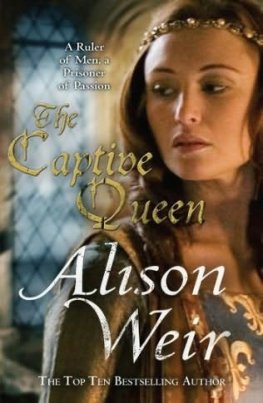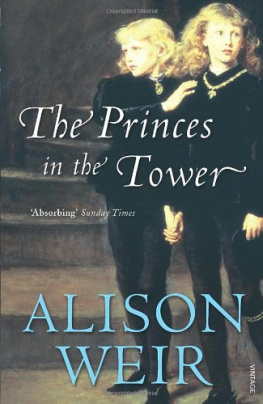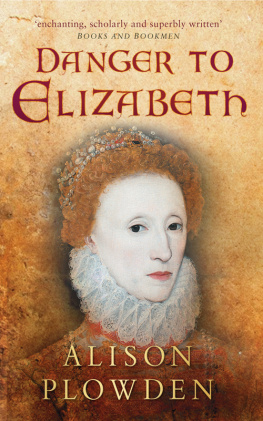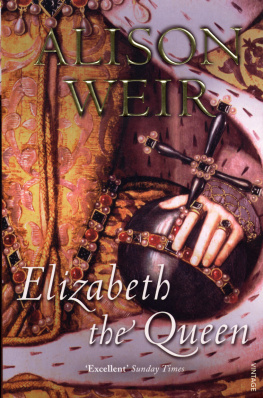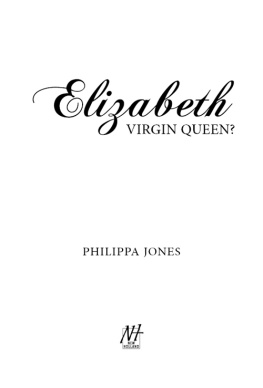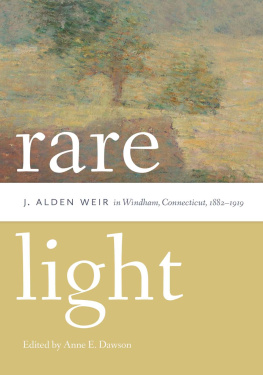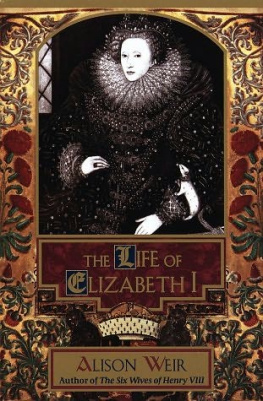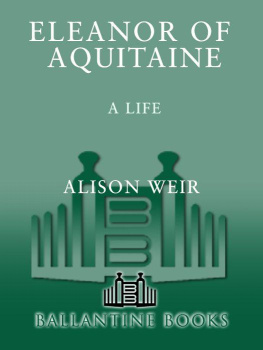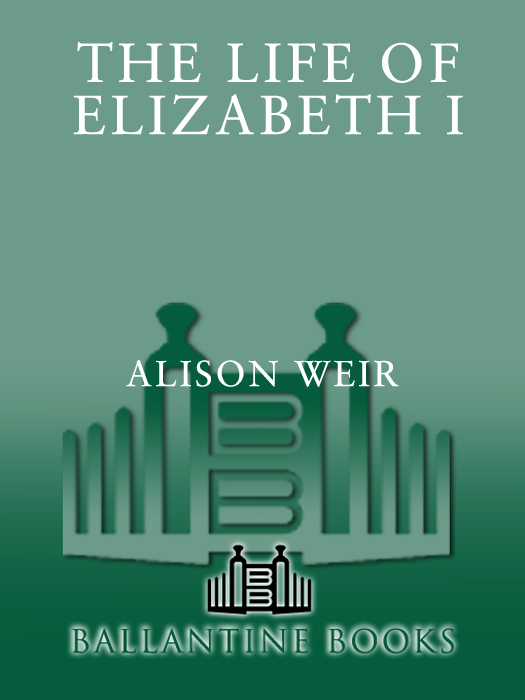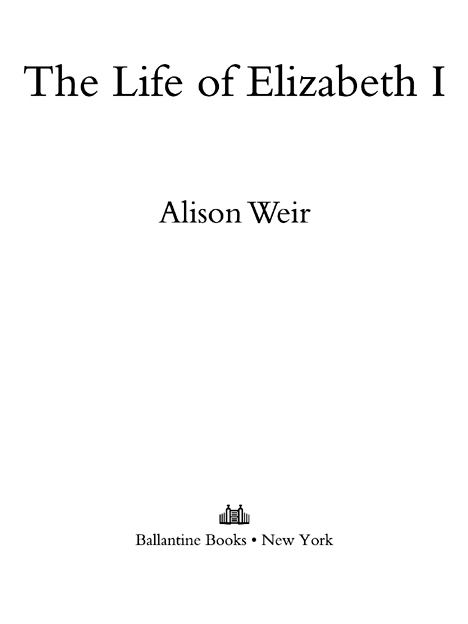Praise forThe Life of Elizabeth I
[This] biography is by an accomplished expert on the period. It is full, fair, and judicious, and particularly good on Elizabeths private life, on the men such as Leicester and Essex whom she viewed with a mixture of affection and irritationthey were both her intellectual inferiorsand her abortive marriage schemes. I enjoyed it, and I think many other readers will too.
Literary Review
Informative and entertaining [An] eloquent biography of absorbing interest.
The Times (London)
New interpretations and insights into perhaps the most influential English sovereign.
Indianapolis Star
A thoroughly readable insight into a queens life and her effect upon her society and subjects.
Bangor & Anglesey Mail
The long life and powerful personality of Englands beloved Virgin Queen have eternal appeal, and popular historian Alison Weir depicts both with panache. Shes especially good at evoking the physical texture of Tudor England. Weir does a fine job of retelling this always-popular story for a new generation.
Amazon.com
A riveting portrait of the queen and how the private woman won her public role. Acclaimed Tudor biographer Weir paints a vast canvas but maintains a sharp focus on Elizabeths charismatic character and her reactions to people and events around her. This volume represents the culmination of years of research by Weir. Here she brings her characteristic exhaustive attention to detail, an experienced sense of narrative pace and style, and a passion for her subject.
Kirkus Reviews (starred review)
Weir uses myriad details of dress, correspondence and contemporary accounts to create an almost affectionate portrait of a strong, well-educated ruler loved by her courtiers and people alike. [She] brings a fine sense of selection and considerable zest to her portrait of the self-styled Virgin Queen.
Publishers Weekly
2008 Ballantine Books Trade Paperback Edition
Copyright 1998 by Alison Weir
Reading group guide copyright 2003, 2008 by Random House, Inc.
All rights reserved.
Published in the United States by Ballantine Books, an imprint of The Random House Publishing Group, a division of Random House, Inc., New York.
B ALLANTINE and colophon are registered trademarks of Random House, Inc.
R ANDOM H OUSE R EADER S C IRCLE and colophon are trademarks of Random House, Inc.
Originally published in hardcover in the United States by Ballantine Books, an imprint of The Random House Publishing Group, a division of Random House, Inc., and in the United Kingdom
by Jonathon Cape, a division of Random House, UK, in 1998. A trade paperback edition was published in the United States by Ballantine Books, an imprint of The Random House Publishing Group, a division of Random House, Inc., in 1999.
eISBN: 978-0-307-83460-7
www.randomhousereaderscircle.com
v3.1
Contents
Authors Preface
The Life of Elizabeth I is the third volume in my series of books on the Tudor monarchs. Having chronicled Elizabeth Tudors childhood in The Six Wives of Henry VIII and her formative years in The Children of Henry VIII, I found the prospect of writing about her life as Queen of England irresistible.
This was never meant to be a political biography, nor did I intend to write a social history of the times. My aim has always been to write a history of Elizabeths personal life within the framework of her reign, drawing on her own extensive literary remains, as well as those of her contemporaries. The manuscript was originally entitled The Private Life of Elizabeth I, but it very soon became apparent that Elizabeths private life was a very public one indeed, hence the change of title. Nor is it possible to write a personal history of her without encompassing the political and social events that made up the fabric of her life. What I have tried to do, therefore, is weave into the narrative enough about them to make sense of the story, and emphasise Elizabeths reaction to them, showing how she influenced the history of her time.
The Elizabethan Age is a vast canvas, and there are so many aspects to Elizabeth and her reign that the writers hardest task is choosing what to include and what to leave out. The details I have included are those which best portray Elizabeth as queen and woman, and which illustrate the many facets of her character.
There are many stories threaded through the book: Elizabeth and Leicester, Elizabeth and Mary Stuart, Elizabeth and Philip of Spain, Elizabeth and Essex, and, of course, Elizabeth and her many suitors. In presenting events chronologically, I have woven all these threads together into a single narrative although, at times, it has felt as if I have been writing four different books!
Queen Elizabeth was such a fascinating and charismatic character that her life as queen merits a book of its own. In her time, monarchs ruled as well as reigned, and the personality of the sovereign could have a profound effect upon the history of the kingdom. This is a study of personal government at its best.
Alison Weir
Carshalton, 1998
Prologue: 17 November 1558
B etween eleven and twelve oclock on the morning of 17 November 1558, large crowds gathered outside the Palace of Westminster and at other places in London. Presently, heralds appeared, announced the death, earlier that morning, of Mary I, and proclaimed her half-sister Elizabeth Queen of England. Even as they spoke, the Lord Chancellor Nicholas Heath, Archbishop of York, was announcing the new monarchs accession to the House of Lords.
As Londoners joyfully celebrated the death of the woman whom they had of late come to regard as a tyrant and her replacement by one widely looked upon as their deliverer, the lords of the Privy Council were arriving at the royal palace at Hatfield in Hertfordshire, where the Lady Elizabeth had been living in judicious obscurity after narrowly evading her half-sisters attempts to deprive her of the crown. Here, as noon approached, the princess, unheeding of the bitter cold, was taking the air in the park surrounding the palace, seated beneath an old oak tree, reading a book.
She was not unaware of her imminent change of status. For several days now, courtiers and councillors with an eye to the future had been deserting the court of the dying Queen Mary and wending their way north to Hatfield to demonstrate their loyalty to her youthful heiress. Yet, when the lords of the Council came and knelt before her in the park, saluting her as their sovereign lady, Elizabeth was for a few moments speechless. Struggling with her emotions, she sank to her knees on the grass, and pronounced in Latin, This is the Lords doing: it is marvellous in our eyes.
Then she rose and, having recovered her composure, led the way back to the palace to receive the acclaim of her people and begin the business of ruling England.
Introduction Elizabeths England
M ary Tudor, the first female English monarch, had reigned for five unhappy years. The daughter of Henry VIII by his first wife, Katherine of Aragon, she had suffered a miserable youth as a result of her fathers treatment of her mother, whose marriage had been annulled so that Henry could marry her lady in waiting, Anne Boleyn. A fervent Catholic, Mary had also been appalled by her fathers break with Rome and later by the establishment of the Protestant faith in England by her brother, Edward VI, Henrys child by his third wife, Jane Seymour, whom he had married after Anne Boleyn was beheaded for treason. Hence when Edward died prematurely at fifteen in 1553, and Mary, his heiress, having overcome a Protestant plot to replace her with her cousin, Lady Jane Grey, ascended the throne to unprecedented public acclaim, she resolved to restore the Catholic faith. But in order to produce Catholic heirs to carry on her work, she made a fatally ill-judged and unpopular marriage with Europes premier Catholic ruler, Philip of Spain, and at a stroke lost the love of her subjects. Matters were made worse when she reintroduced the laws against heresy and sanctioned the burning of some three hundred English Protestants an act that would later earn her the sobriquet Bloody Mary. In the last year of her reign, England lost Calais, the last outpost of her great medieval continental Empire, to the French, and Mary was blamed for it. Having suffered two phantom pregnancies and been deserted by her husband, she sickened and died, a very unhappy woman.






